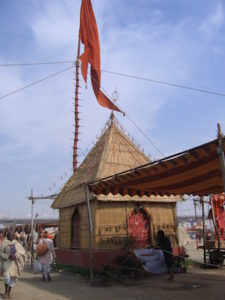
The Kumbh Mela area is broadly separated according to the various Sannyas or Shaiva akhadas and Vairagi/Sadhu or Vaishnav Akhadas as well as other Sampradayas. At Prayagraj, there is also considerable land allocated to the Kalpvasis. Romola Butalia writes about the Akhadas at the Kumbha Mela.
Activities at Kumbh
 At a Mahakumbh, Kumbh and Ardhkumbh the main activities include the sacred ritual snan or dip. Additionally, people go to the Kumbh for darshan of the various saints and mahatmas, and for satsangh and to hear discourses. Certainly, the Kumbh is a compelling attraction. Moreover, the colour, the traditions, the flamboyance and the unique lifestyles of the various groups at the Kumbh, hold an undeniable appeal. Traditionally, the presence of the sages and saints held a deep spiritual significance.
At a Mahakumbh, Kumbh and Ardhkumbh the main activities include the sacred ritual snan or dip. Additionally, people go to the Kumbh for darshan of the various saints and mahatmas, and for satsangh and to hear discourses. Certainly, the Kumbh is a compelling attraction. Moreover, the colour, the traditions, the flamboyance and the unique lifestyles of the various groups at the Kumbh, hold an undeniable appeal. Traditionally, the presence of the sages and saints held a deep spiritual significance.
The various Akhadas were created to safeguard the Hindu way of life. This was considered particularly relevant during times of invasions.The Sannyas and Sadhu Samaj have a rigorous discipline in Yet this is not immediately apparent to the casual observer.
Dharma, Artha, Kaam, Moksha
The rishis of yore developed the four Purusharthas. Within each phase, the objectives and attributes of life were expected to be fulfilled. Hence, the four ashrama or stages in life begin with Brahmachari ashram, the life of a student. Next follows grihastha ashram as a householder. Aspirations and desires are fulfilled in this phase. Thirdly, the vanaprastha ashrama is social retirement. Finally, during sannyas is to explore the nature of Self, experience wholeness and strive for enlightenment. Therefore these four phases are so that the four goals of artha, kaam, dharma and moksha are achieved. Consequently, it was expected that everyone wold progress through these transitory phases to fulfil the purpose of life.
Later, because many people got involved in artha and kaam and lost the clarity to transit to later phases within the life cycle, some people renounced the world in order to focus on dharma and moksha and be able to develop techniques for balanced living for society. Such thinkers were known as vidwans and they devised the social code of conduct.
Shaiv Akhadas
 Adi Shankaracharya was born in the 8th century. He propagated the Advaita Vedanta philosophy. Moreover, he established the Dashnami Sannyasa tradition and thereby unified the various diverse groups of sannyasins. He brought them under the banner of Sanatana Dharma. Adi Shankaracharya classified the Adwaitvadi Sannyasins into ten groups : Giri, Puri, Bharti, Tirtha, Van, Aranya, Parvat, Ashram, Sagar and Saraswati. This organisation is known as Dashnami Sangh. Dashnami Sannyasins convey his eternal message of the synthesis of all beliefs. Advaita is the monistic vision of reality whereby all that exists is ultimately One.
Adi Shankaracharya was born in the 8th century. He propagated the Advaita Vedanta philosophy. Moreover, he established the Dashnami Sannyasa tradition and thereby unified the various diverse groups of sannyasins. He brought them under the banner of Sanatana Dharma. Adi Shankaracharya classified the Adwaitvadi Sannyasins into ten groups : Giri, Puri, Bharti, Tirtha, Van, Aranya, Parvat, Ashram, Sagar and Saraswati. This organisation is known as Dashnami Sangh. Dashnami Sannyasins convey his eternal message of the synthesis of all beliefs. Advaita is the monistic vision of reality whereby all that exists is ultimately One.
Adi Shankaracharya brought together all such groups. He created the Dashnami sannyas and thereby gave them an identity. These ten different groups follow varied ideologies and philosophical paths. These ten different groups excelled in their own systems of philosophies, beliefs and practices. For instance, the order of Saraswati excelled in Advaita, Vedanta and Yoga. Similarly, the Giri tradition mastered Hatha Yoga, Tapasya and Tantra. And the Puri tradition focused on the Sankhya system of thought. Each of the ten different sampradayas followed a specific belief system. They also propagated particular techniques to act as catalysts on the path of enlightenment.
Vaishnav Akhadas and other Sampradays
 TheDa shnami Sangha created by Adi Shankarcharya exists. Additionally, Ramanujacharya also established seven Maths. Furthermore, Madhavacharya, Shri Ramanandji Nimbark, Vallabhachrya Chaitanya Mahaprabhu also established their own Maths.
TheDa shnami Sangha created by Adi Shankarcharya exists. Additionally, Ramanujacharya also established seven Maths. Furthermore, Madhavacharya, Shri Ramanandji Nimbark, Vallabhachrya Chaitanya Mahaprabhu also established their own Maths.
The Buddha established his own tradition of sannyas in the form of bhikshus and bhikshunis. Additionally, Lord Mahavira established his form of sannyas as Digambar. Later, came the Swetambaras, dressed in white. Again, the Tantrics evolved their own system of sannyas using the colours of red and black.
Other than these, separate distinct sampradayas or groups follow their own traditions. Like the various Nath traditions.
Kumbh Kshetra and Akhadas
Each Akhada has an area allocated to them. Different camp sites are accordingly allocated to individual saints or maths and ashrams. This caters to sectarian differences and sentiments. The following broad classification exists:
Shaiv or Sannyas Sampraday
Panchadashanam Juna Akhada
Panchayati Mahanirwani Akhada
Taponidhi Niranjani Akhada
Panchayati Atal Akhada
Taponidhi Anand Akhada
Panchadashnam Awahan Akhada
Pancha Agni Akhada
Vairagi Sadhu or Vaishnav Sampraday
Nirmohi Ani
Digambar Ani
Nirawani Ani
Udasin Panth
Bada Udasin Akhara
Naya Udasin Akhara
Nirmal Panchyati Akhara
Kalpvasis
Every year in the month of Magh, lakhs of pilgrims converge at Prayagraj. These pilgrims are known as Kalpvasis. They spend about 40 days in sadhana and tapasya and practise austerities. Additionally, Kalpvasis live in tents on the banks of the Ganga, eat a single meal, and take a daily ritual dip in the cold winter waters of the Ganga.

Leave a Reply